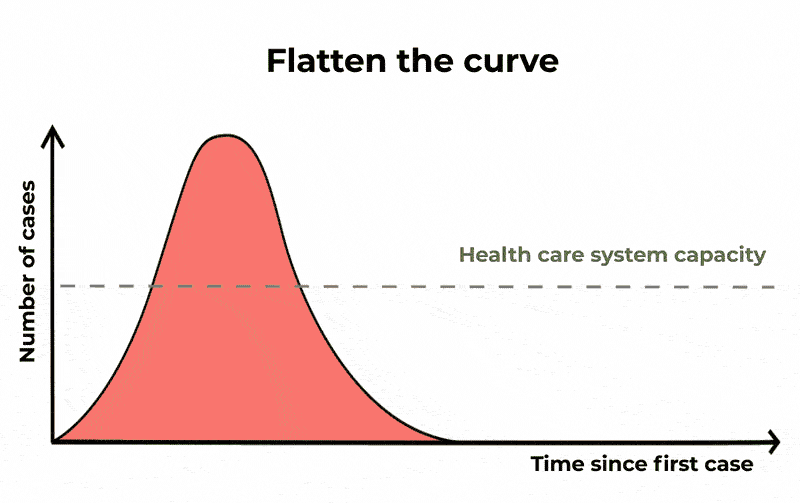Coronavirus cases are growing exponentially – here's what that means
- Written by Andrew D. Hwang, Associate Professor of Mathematics, College of the Holy Cross
In the U.S., scientists stress that the number of coronavirus cases has been growing exponentially[1]. In ordinary speech, the term “exponential” usually means “really fast.”
To mathematicians like myself[2], and to scientists and public health officials, the term has a precise and subtly different meaning: A quantity is “exponential” if its rate of change at each point is proportional to the current size[3].
Let’s explore why the difference matters, and how exponential processes can mislead our perception of risk.
When an exponential quantity is small, its change is slight; when the quantity is large, the change is rapid. Thanks to exponential growth, epidemics start slowly, then balloon with surprising speed.
This pattern presents a distinctive challenge. People intuitively underestimate exponential growth[4]. By the time individuals sense their peril and act, the damage has been multiplied many-fold.
In an epidemic, numerical data and mathematical models are like night-vision goggles, illuminating what cannot be directly perceived.
Origins of exponential growth
To a good approximation, viruses spread exponentially in unexposed populations. Each infected individual meets others at random[5]. At each meeting, there is some chance of the virus being transmitted.
The number of new cases in a one-day period – the rate of increase of infection, in individuals per day – is proportional to the number currently infected.
Exponential quantities have a characteristic interval over which the quantity doubles. For illustration, consider an epidemic that doubles daily[6]. If one person is infected today, two are infected tomorrow, four the day after tomorrow, eight the day after that, then 16, 32, 64. After one week, 128. Three days after that, 1,024 are infected.
Let’s flag two items about this example.
First, the number of new cases tomorrow equals the total number of cases today.
Second, 10 doublings, here 10 days, gives a thousand-fold increase in cases.
How many doublings give a million-fold increase? A million is a thousand thousand. It takes 10 doublings for 1,000 to become 1,000,000, 20 days total.
This percentage growth is constant, one doubling per day. In absolute numbers, however, an initial trickle grows rapidly into an uncontrollable flood.
Stopping an outbreak early
In an epidemic, early action saves lives[7]. Conversely, delay in public health response inflates case numbers exponentially.
The Centers for Disease Control and Prevention[8] and World Health Organization[9] had flagged the coronavirus as a U.S. public health concern by Jan. 21. At that time, there were only a few confirmed U.S. cases. Isolation of the infected and monitoring of their social contacts was technically feasible. Aggressive testing could have better revealed the true number and locations of cases.
Though testing in the first half of March was mostly confined to individuals needing hospitalization[10], even those numbers show the coronavirus doubling time in the U.S.[11] was at most two and a half days.
Under these conditions, each eight-day delay in public health response translates into roughly 10 times as many cases and deaths as immediate action.
 Flattening the curve is another way of saying buying more time.
Flattening the curve is another way of saying buying more time.Flattening the curve
An exponential quantity is characterized by its starting value and its doubling time. By waiting until mid-March to act as a nation, the U.S. lost control over the starting value.
At any stage, however, people can collectively help lengthen the doubling time. Personal hygiene and social distancing effectively reduce viral transmission[12]. Slowing the epidemic “flattens the curve[13].” The goal is to reduce the maximum number who are hospitalized at any given time and avoid overwhelming the medical system.
There are at least two civic lessons.
We citizens must recognize and respect the creeping-to-explosive nature of exponential growth. Epidemics start small and slowly. The CDC is equipped to detect potential outbreaks in early stages[14], but it needs the backing of government and the public to fulfill its mission.
Second, we must understand that the public health system undercuts its own public reputation by succeeding. When an epidemic is halted in its early stages, the public seldom knows. The enormous invisible benefits of public health take the form of averted disaster.
[Get facts about coronavirus and the latest research. Sign up for our newsletter[15].]
References
- ^ number of coronavirus cases has been growing exponentially (www.washingtonpost.com)
- ^ mathematicians like myself (mathcs.holycross.edu)
- ^ its rate of change at each point is proportional to the current size (www.mathsisfun.com)
- ^ underestimate exponential growth (link.springer.com)
- ^ Each infected individual meets others at random (www.washingtonpost.com)
- ^ doubles daily (www.forbes.com)
- ^ early action saves lives (www.who.int)
- ^ Centers for Disease Control and Prevention (www.cdc.gov)
- ^ World Health Organization (www.who.int)
- ^ mostly confined to individuals needing hospitalization (www.npr.org)
- ^ doubling time in the U.S. (www.worldometers.info)
- ^ reduce viral transmission (www.cdc.gov)
- ^ flattens the curve (www.washingtonpost.com)
- ^ equipped to detect potential outbreaks in early stages (www.cdc.gov)
- ^ Sign up for our newsletter (theconversation.com)
Authors: Andrew D. Hwang, Associate Professor of Mathematics, College of the Holy Cross
Read more https://theconversation.com/coronavirus-cases-are-growing-exponentially-heres-what-that-means-135181

